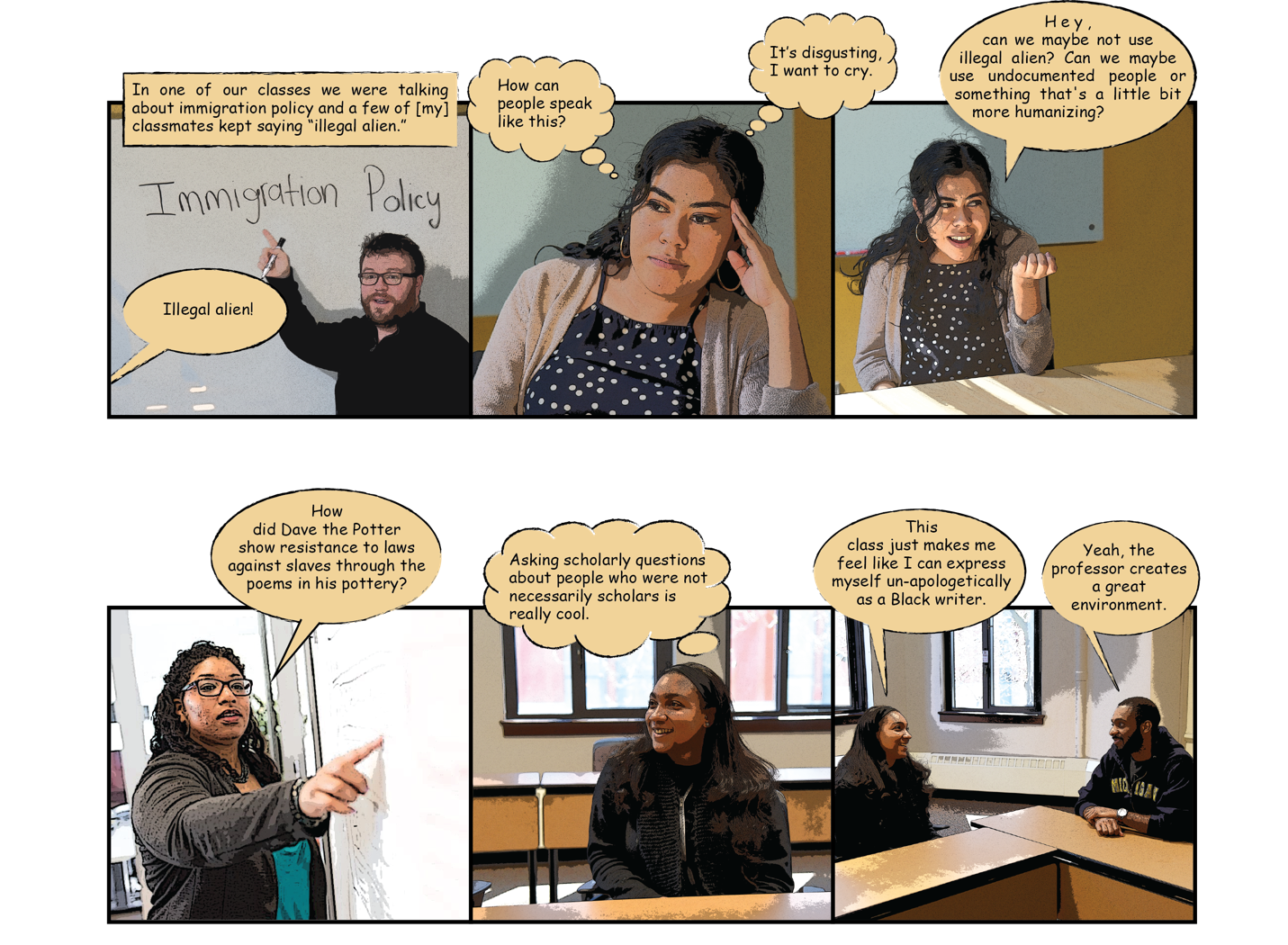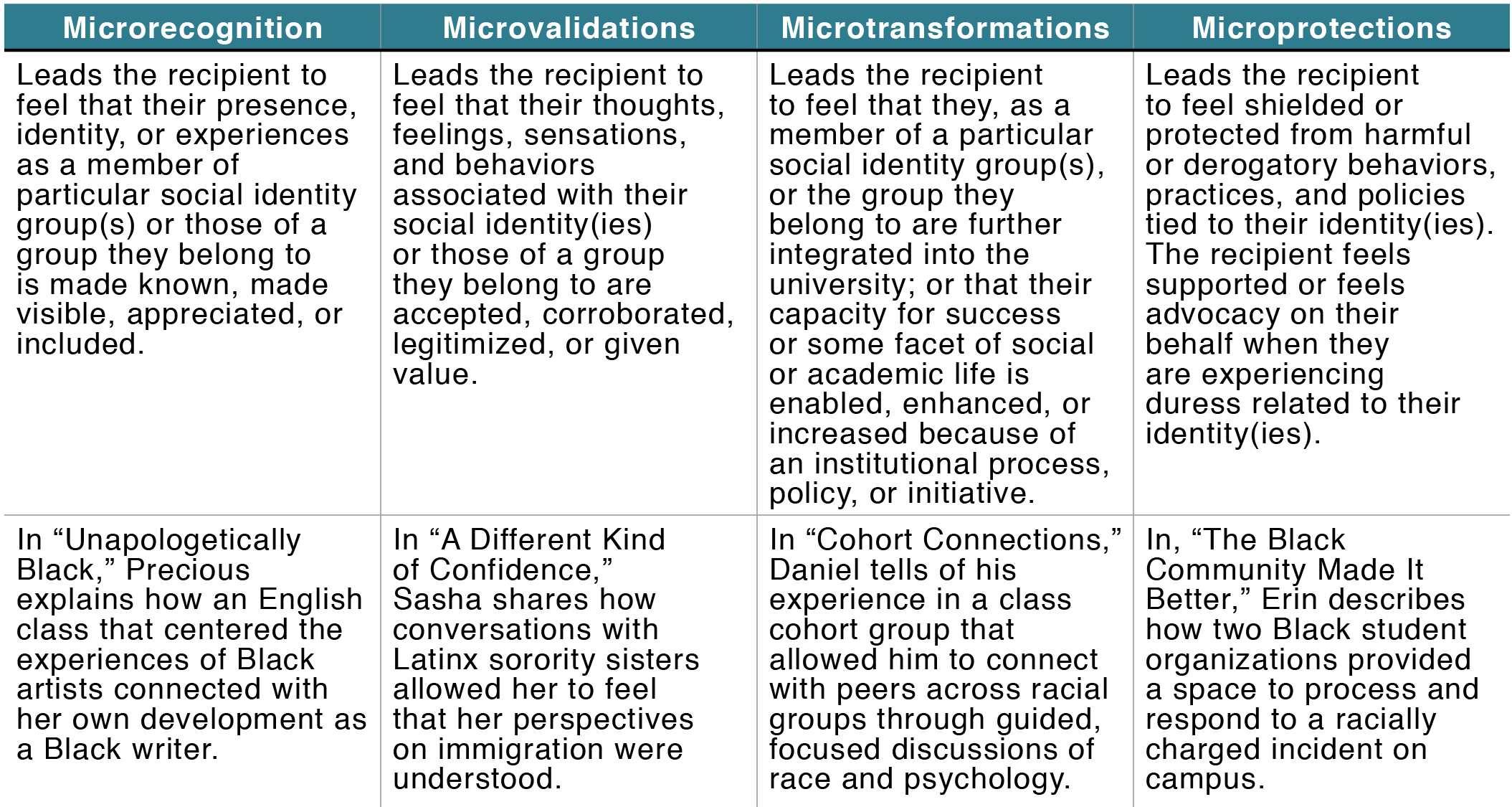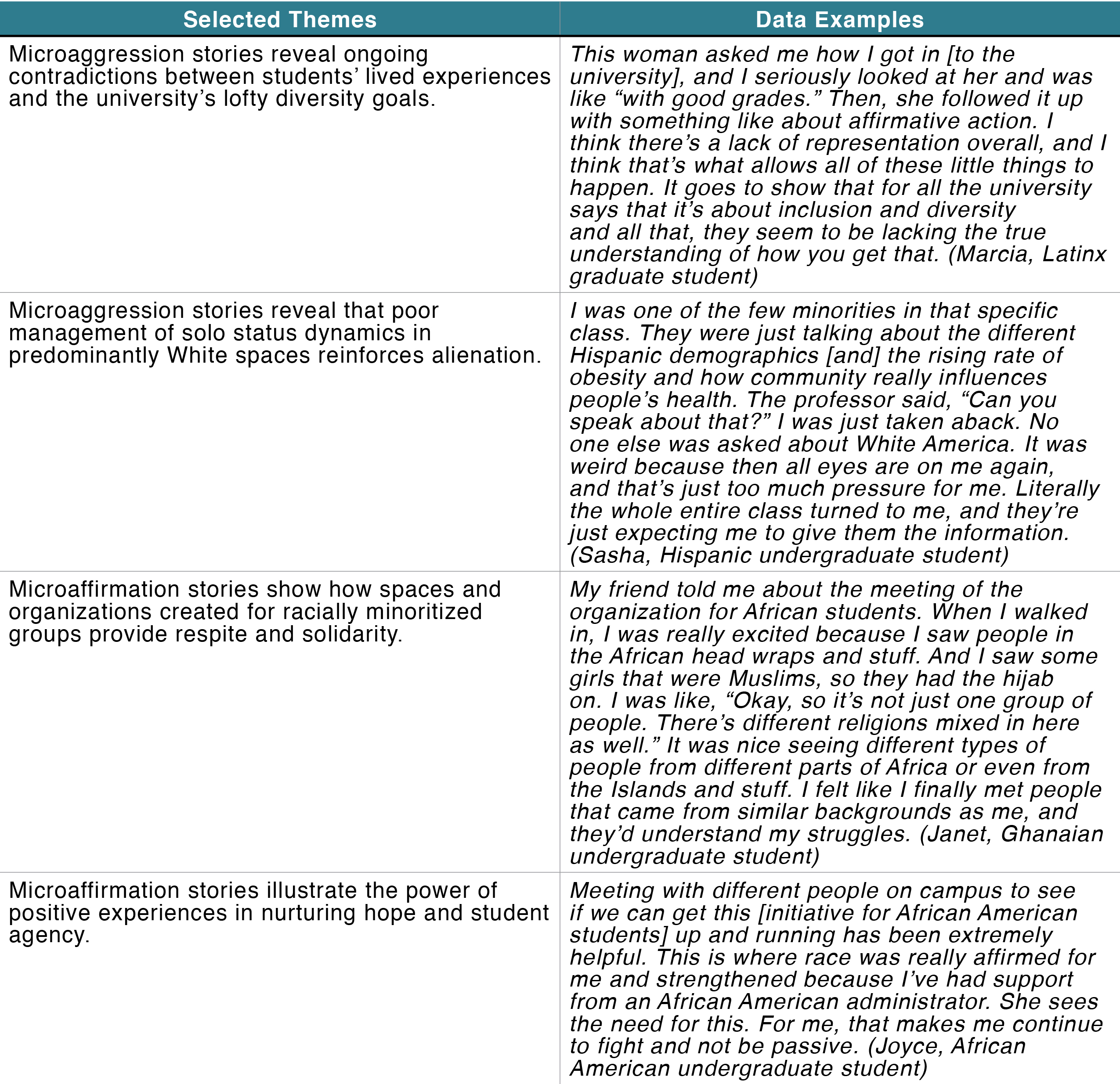Stories of Microaggressions and Microaffirmation: A Framework for Understanding Campus Racial Climate
Skip other details (including permanent urls, DOI, citation information)
: This work is licensed under a Creative Commons Attribution-NonCommercial-NoDerivatives 4.0 International License. Please contact [email protected] to use this work in a way not covered by the license.
For more information, read Michigan Publishing's access and usage policy.
Introduction
Racially minoritized students continue to report more negative perceptions of campus racial climate for than their White classmates (Hurtado & Ponjuan, 2005; Johnson et al., 2007). In the stories illustrated above, Celeste and Precious described personal interactions experienced in the course of their everyday lives as university students. Precious’s story illustrates a racial microaffirmation (MAF), defined as actions, words, or environmental cues that fosters inclusion or promote the success of racially minoritized students by recognizing their racial identity, validating their racialized realities, resisting racism, or advancing cultural and ideological norms of racial justice (Rolón-Dow & Davison, 2018). Celeste’s story provides an example of a microaggression (MAG), defined as actions or words, often subtle or covert, that stereotype, insult, or invalidate racially minoritized people in the course of their everyday lives (Pierce, 1974; Sue et al., 2007). University missions are increasingly emphasizing diversity, equity, and inclusion as important elements; thus, attention to the interactions that minoritized students experience and to what these interactions suggest about campus racial climates is essential. Studying MAGs and MAFs provides an avenue for understanding how racially minoritized students’ daily experiences related to race and/or other social identities shape their perceptions of campus climate.
This paper reports on an ongoing research project that utilizes a critical race theory (CRT) storytelling approach to document, analyze, and learn from the MAG and MAF experiences that students share. The paper will outline conceptual and methodological approaches that guide the project. I illustrate the value of a storytelling approach and how it produces knowledge that is helpful in revealing racialized dimensions of campus climates; I also suggest research and practice implications from this approach.
CRT: The Foundation for Understanding Microaggressions and Microaffirmations
Perceptions of campus climate are shaped by lived experiences that include acts, conversations, and environmental cues that members of a university community confront in the course of everyday lives. Previous work by CRT scholars (see, e.g., Garcia, Johnston, Garibay, Herrera, & Giraldo, 2011; Harper et al., 2011; McCabe, 2009; Solorzano, Ceja, & Yosso, 2000; Yosso, Smith, Ceja, & Solórzano, 2009) outlined the ways in which racially minoritized students experience MAGs and their deleterious impact on the racial climate of universities. MAFs, however, have received less attention. Rowe (2008) introduced the concept to explain the ways that individuals from underrepresented groups in her university context were affirmed and supported despite the obstacles they faced. My study allowed me to more precisely define and illustrate racial MAFs. Understanding the ways both MAGs and MAFs influence student experiences is in line with advancing CRT analyses of the ways race operates within institutions and the ways it shapes perceptions of campus climate.
Methods
This study used narrative interviews, a method that encourages participants to retell stories about important events, the social context in which they occurred, and the feelings associated with them (Muylaert, Sarubbi, Gallo, Neto, & Reis, 2014). To solicit a story about a MAG, we asked students to describe an experience in which they felt misunderstood, disrespected, insulted, or excluded in relation to their social identity. To solicit a story about a MAF, we asked students to describe an experience in which they felt affirmed, respected, strengthened, protected, or included in relation to their social identity. Participants were also asked how these stories informed their understanding of the racial dimensions of their university’s campus climate.
Data collection was completed in 2016–2017 at a predominantly White university on the East Coast. Participants were recruited through contact with organizations and programs on campus geared toward racially minoritized students. Snowball sampling, recruiting through personal networks of the participants as well as students working on the project, was also utilized. Participants included twenty-seven undergraduate and twenty graduate students from racially minoritized groups. The research team consisted of a Latinx faculty member, four female graduate students (three African American, one Asian/Black), and three African American undergraduate students.
After transcription, the 30 to 60 minute interviews were restoried (Ollerenshaw & Creswell, 2002), a process that led to the creation of two or more brief vignettes per participant, one describing a MAG and one a MAF. The vignettes were shared with each participant to ensure they adequately captured their stories.
Varied analytic exercises were conducted, including analysis of stories to identify MAF types, classification using the developed typologies, and thematic coding across stories. In the following section, I draw on the study’s findings to outline some of the benefits of this methodology for understanding campus racial climate.
Insights: Learning through CRT Storytelling
Stories Nurture Humanized Understandings of Campus Climate
Do I Belong Here?
Hearing some people's conversations would kind of be hurtful. [One time] I was just studying in the lounge and there was probably around seven or eight people; [they were] White men and women talking in the lounge. They were talking about minorities and getting financial aid and how the only reason we're able to afford it is because we get handouts. They were just saying, "Yes you have to be piss poor or a minority to get any money. You basically have to be dead broke." I don't think they really cared that I was there, and I think they were just having their own conversation; they were going to talk about whatever they want to talk about no matter who is in the room. I think it made me question: Do I belong here? (Shawna, African American undergraduate student)
The narratives produced through this CRT storytelling approach contribute to a broader understanding of campus climate by building a body of knowledge on cultural practices and policies that racially minoritized students find aggressive or affirming in their daily experiences. This research project reflects the importance of understanding racial MAGs and MAFs from the vantage point of the recipient. That is, it prioritizes how MAGs and MAFs are felt and interpreted by the person experiencing them, rather than focusing on the intent motivating MAGs and MAFs. This format also allows for attention to the social-emotional component of MAGs and MAFs. For example, Shawna’s story, “Do I Belong Here?,” was one of several undergraduate stories of experiences in residence halls that illustrated the taxing nature of being in predominantly White spaces and the feelings of loneliness or alienation this produced. Several graduate student stories highlighted the ways that personal invitations into events at student-led organizations for underrepresented students nurtured a sense of community or encouraged pride in different facets of their identities. I prioritize personal narratives because the story format can encourage empathy and highlight the humanity of others (Huber, Caine, Huber, & Steeves, 2013), key elements to deepening understanding of the ways that campus climate is lived and felt by students from diverse backgrounds and identities.
Stories Facilitate Typology Development and Classification
A CRT storytelling approach is useful in illustrating different types of affirmations and aggressions that students experience in their daily life. I used existing research on MAG types (Sue et al., 2007; Yosso, Smith, Ceja, & Solórzano, 2009) to classify each MAG story into one of four categories: microinsults, microinvalidation, microassault, or institutional microaggression. In addition, the student stories provided an essential guide in the creation of a MAF typology (Rolón-Dow & Davison, 2018), helpful for understanding the variety of ways that students experience affirmation. Table 1 (see Appendix) provides definitions of the four MAF types along with brief descriptions of one story classified under each type. The classification process allows for more nuanced understandings of MAG and MAF experiences; these understandings can then be shared and utilized by various higher education constituents. Knowledge on the types of MAGs or MAFs students are experiencing can inform the ways MAGs or MAFs are addressed or promoted on campus.
Stories Enable Exploration of Specificity
CRT scholars argue that counterstories provide particular understandings of how contexts operate for marginalized groups (Delgado, 1993). CRT storytelling is helpful in producing holistic understandings of MAFs and MAGs in relation to the specific campus climates of particular institutions. The storytelling process encourages students to elaborate on contextual details that shape interactions, comments, or environmental cues that they find aggressive or affirming within their specific campus environment. For example, Solomon’s story, “Feels Like Home,” references programming and spaces affirming to him.
Feels Like Home
The office that’s for international students is a very nice place to hang out. When I go there I always have that sense of belonging. You see people from other countries and you relate. There’s also an association for Black graduate students and that has also been a very good avenue to relate with people with brown skin like myself. I hear stories from other people depending on the event we're having. You have a sense that you're in this together with some other people. People are also having to push through some difficulties or some challenges. It gives you some kind of comfort and reinforces your ability to go back and push forward. I think those are just a little of some of the experiences that makes this place feel like home, despite the challenges and some of the struggle you go through. But I had to look out for these organizations. You don't get some of these benefits unless you associate with them. (Solomon, Black international graduate student)
Other students shared how particular diversity initiatives and policies influenced their experiences. Students also spoke of the ways race and social class demographics and histories specific to their institution impacted their experiences. Our analysis also includes attention to the gestalt that the collection of stories produces about a specific university’s campus climate. Collections of stories at specific universities can help identify problematic practices as well as potential resources within those institutions and can be helpful in addressing racialized dynamics and promoting racial justice work in locally relevant ways.
Stories Point to Broader Systemic Issues
A CRT framework for analysis requires attention to the broader systemic racial and diversity issues and the racialized institutional practices and policies that shape the experiences of individuals (Pérez Huber & Solorzano, 2015). Because the study is undergirded by CRT principles, it seeks to understand the elements of race and racism that are normalized through MAGs and the ways MAFs acknowledge or disrupt institutional policies or practices that sustain racism. As illustrated in Table 2 (see Appendix), data analysis included exploring themes related to systemic issues across stories. This thematic analysis is helpful in deepening understandings of macroaggressions, defined by Pérez Huber and Solorzano (2015) as the beliefs or ideologies, that “justify the actions of racism in the many forms they take including institutional racism and racial microaggressions” (p. 7). An illustration of how this type of analysis is useful in illustrating broader systemic and ideological issues is available in Jones and Rolón-Dow (2018).
Implications
This project builds on the work of previous CRT scholars that used storytelling to produce understandings of campus climate that account for the perspectives of racially minoritized groups. The following outlines several research implications from this project and several practical recommendations relevant to colleges and universities:
- The CRT storytelling approach is grounded in the belief that nuance, specificity, and depth matters in understanding how race and racism impact higher education settings. The MAG literature includes strong foundational work on different higher education contexts and different elements of MAG experiences (nature of incident, context, response, etc.). Additional research is needed to bring the same type of complexity to the study of MAFs. We also need to better understand the relationship between MAGs, MAFs, and perceptions of campus climate and to integrate these understandings into campus climate models. And we need additional work to better elucidate intersectional MAGs and MAFs and to integrate this work into the CRT scholarship on campus climate.
- In the insights listed above, I highlighted some of the affordances of a storytelling approach. The practice of listening is also embedded within the storytelling approach. First, a listening stance is central to the data collection process. But the potential of listening also extends to practical uses of the stories produced from the data. Listening to stories is valuable in developing professional development opportunities for different members of campus communities. It can lead to better understandings of the ways students experience different dimensions (academic, social, etc.) of campus life in a variety of campus spaces. Furthermore, listening can promote enhanced knowledge of the ways race and racism continue to operate within the particular sociocultural and historical dynamics of local contexts.
- A noteworthy conclusion from our study is that MAFs make a difference in the lives of students and in the campus climate. These experiences can enhance students’ academic or social success, help them feel represented, strengthen their sense of belonging in an academic program or as part of the larger university, validate different elements of social identities, or cultivate agency or hope for addressing challenges or capitalizing on their assets and resources. Nurturing and sustaining a microaffirming climate, however, requires intentionality and a long-term commitment. It requires ongoing attention to the ways students from diverse racial groups experience the campus environment. It requires a commitment to review and adapt policies and practices with the goal of increasing the inclusion and capacity for success of racially minoritized groups. Initiatives to assess how well current programs or offices create a microaffirming climate should be undertaken. Furthermore, positive incentives may be helpful. Programs, faculty, or administrators with a strong track record of promoting the success of racially minoritized students should be highlighted and rewarded by their institutions.
References
- Delgado, R. (1993). On telling stories in school: A reply to Farber and Sherry. Vanderbilt Law Review, 46, 665–675
- Garcia, G. A., Johnston, M. P., Garibay, J. C., Herrera, F. A., & Giraldo, L. G. (2011). When parties become racialized: Deconstructing racially themed parties. Journal of Student Affairs Research and Practice, 48(1), 5–21.
- Harper, S. R., Davis, R. J., Jones, D. E., McGowan, B. L., Ingram, T. N., & Platt, C. S. (2011). Race and racism in the experiences of Black male resident assistants at predominantly White universities. Journal of College Student Development, 52(2), 180–200.
- Huber, J., Caine, V., Huber, M., & Steeves, P. (2013). Narrative inquiry as pedagogy in education: The extraordinary potential of living, telling, retelling, and reliving stories of experience. Review of Research in Education, 37(1), 212–242.
- Hurtado, S., & Ponjuan, L. (2005). Latino educational outcomes and the campus climate. Journal of Hispanic Higher Education, 4(3), 235–251.
- Johnson, D. R., Soldner, M., Leonard, J. B., Alvarez, P., Inkelas, K. K., Rowan-Kenyon, H., & Longerbeam, S. (2007). Examining sense of belonging among first-year undergraduates from different racial/ethnic groups. Journal of College Student Development, 48(5), 525–542.
- Jones, J., & Rolón-Dow, R. (2018). Multidimensional models of microaggressions and microaffirmations. In C. M. Capodilupo, K. L. Nadal, D. P. Rivera, D. W. Sue, & G. C. Torino (Eds.), Microaggression Theory: Influence and Implications (pp. 32–47). Wiley Online Library.https://doi.org/10.1002/9781119466642.ch3
- McCabe, J. (2009). Racial and gender microaggressions on a predominantly-white campus: Experiences of Black, Latina/o and White Undergraduates. Race, Gender & Class, 16(1/2), 133–151.
- Muylaert, C. J., Sarubbi, V., Jr., Gallo, P. R., Neto, M. L. R., & Reis, A. O. A. (2014). Narrative interviews: An important resource in qualitative research. Revista da Escola de Enfermagem daUSP, 48(spe2), 184–189.
- Ollerenshaw, J. A., & Creswell, J. W. (2002). Narrative research: A Comparison of two restorying data analysis approaches. Qualitative Inquiry, 8(3), 329–347.
- Pérez Huber, L., & Solorzano, D. G. (2015). Racial microaggressions as a tool for critical race research. Race Ethnicity and Education, 18(3), 297–320.
- Pierce, C. (1974). Psychiatric problems of the Black minority. In S. Arieti (Ed.), American Handbook of Psychiatry (pp. 512–523). New York, NY: Basic Books.
- Rolón-Dow, R., & Davison, A. (2018, May 21). Racial Microaffirmations: Learning from student stories of moments that matter (CSD Research Briefs, Vol. 1, No. 4), Diversity Discourse: Research Briefs from the Center for the Study of Diversity, University of Delaware.
- Rowe, M. (2008). Micro-affirmation and micro-inequalities. Journal of the International Ombudsman Association, 1(1), 45–48.
- Solorzano, D., Ceja, M., & Yosso, T. (2000). Critical race theory, racial microaggressions, and campus racial climate: The experiences of African American college students. The Journal of Negro Education, 69(1–2), 60–73.
- Sue, D. W., Capodilupo, C. M., Torino, G. C., Bucceri, J. M., Holder, A., Nadal, K. L., & Esquilin, M. (2007). Racial microaggressions in everyday life: Implications for clinical practice. American Psychologist, 62(4), 271–286.
- Yosso, T., Smith, W., Ceja, M., & Solórzano, D. (2009). Critical race theory, racial microaggressions, and campus racial climate for Latina/o undergraduates. Harvard Educational Review, 79(4), 659–691.





